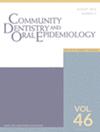Incidence, mortality and survival rates of lip, oral cavity and salivary glands cancers in Singapore: A half-century time trend analysis (1968–2017)
Abstract
Objectives
To examine trends in incidence and mortality and evaluate overall survival (OS) of oral cancer in Singapore between 1968 and 2017.
Methods
All diagnosed oral cancers by anatomical sites and population size were extracted from the Singapore Cancer Registry and the Department of Statistics Singapore. The trend of age-standardized incidence rate (ASIR) and mortality rate (ASMR) (per 100 000 person-years) of the lip, oral cavity and salivary gland cancers were evaluated by Prais-Winsten regressions for each ethnicity and gender. Kaplan–Meier curves were performed to evaluate the OS by anatomical sites in each age group by ethnicity and sex.
Results
Overall, 49, 3494 and 1066 people were diagnosed, and 28, 2310 and 476 died from lip, oral cavity and salivary gland cancers, respectively. The oral cavity cancer ASIR and ASMR reduced from 3.07 (1968–1972) to 2.01(2008–2012) and from 2.06 (1978–1982) to 1.21 (2013–2017) per 100 000 person-years, respectively, with both highest in Indians throughout the whole period. Male:Female ratio ranged from 3.43 (1973–1977) to 1.75 (2013–2017) and from 3.41 (1978–1982) to 2.40 (2013–2017) for ASIR and ASMR, respectively. However, both salivary gland cancer ASIR and ASMR increased from 0.50 (1968–1972) to 0.80 (2008–2012) and from 0.18 (1968–1982) to 0.42 (1988–1992) per 100 000 person-years, respectively, with both higher in males since 1993. Oral cavity cancer ASIR decreased for males aged ≥60, and Indian females ≥25, but increased among Chinese females aged ≥60. Oral cavity cancer ASMR decreased among Chinese aged 25–59, and among Malay males and Indian females. Salivary gland cancer ASIR increased among Chinese males aged ≥60 and Malay males aged 25–59; while ASMR increased among Chinese males aged ≥60. The median OS for oral cavity, lip and salivary gland cancers were 3.0, 9.3 and 18.1 years, respectively, with females surviving longer than males.
Conclusions
Singapore has experienced a decline in the incidence and mortality of lip, oral cancer, an increase in in the incidence and mortality of salivary gland cancer, with an increase in the median overall survival rate. Monitoring the magnitude of oral cancer burden and the demographic, and temporal variations is necessary for tailoring health planning and setting priorities for future clinical care and research.

 求助内容:
求助内容: 应助结果提醒方式:
应助结果提醒方式:


